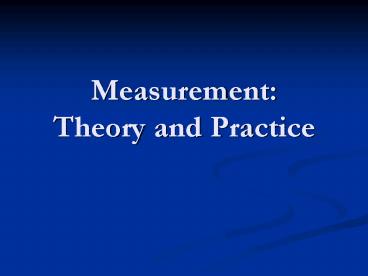Measurement: Theory and Practice - PowerPoint PPT Presentation
1 / 20
Title:
Measurement: Theory and Practice
Description:
Fit Statistics. Does model fit the data? OUTFIT. INFIT. Chi-Square= (X(obs) E (exp))2 ... Square to cancel out and. Divide by variance to standardize. If ... – PowerPoint PPT presentation
Number of Views:30
Avg rating:3.0/5.0
Title: Measurement: Theory and Practice
1
Measurement Theory and Practice
2
Items
- True Score Theory XTE
- Item Response Theory
- Both
- Define construct
- Create many items
- Review items
- Collect data
- Select items, make scale
- Further construct validity
3
Measurement
- Measurement involves abstracting a concrete
ordinal to an interval. - Nominal
- Ordinal
- Interval
- Ratio
4
Measurement
- Counting
- How many apples in a pie, why dont 3 apples
always cost the same - Observations ordinal, measurement must be
interval - Resolution through interval measures (volume,
weight). - Spelling test
- Counting number of words correct does not measure
spelling - Raw scores are not linear, thus biased. All
statistics based on raw scores are biased.
5
Measurement (Thorndike)
- Unidimensional
- Linear
- Abstraction
- Invariance
- Sample-Free
- Additive
6
Guttman Scale
- if a person endorses an extreme statement, then
he/she should endorse less extreme statements on
the scale - Rasch
- A person having greater ability should have the
greater probability of solving any item - F(P)b/d ability/ item difficulty
- Logit natural log odds for succeding on item
7
Logit Metaphor
- Ability Item Difficulty
8
Nominal to Interval
- Data (yes/no), (always, usually, sometimes)
- Observations Ordinal, Measurement Interval
- Combine 2-parameters
- B the location measure of a person
- D location of item
- Log-Odds
9
Estimating B-D
- Initial Attempt Maximum Liklihood parameters
with highest liklihood of producing data. - Log-Odds for items
- Logit Log (P/(1-P) B-D
10
Estimating Liklihood of Data Person
- Item A B C D E Total
- P(M) 1 1 1 0 0 3/5
- P(G) 0 1 1 0 1 3/5
- M1 .5 .27 .12 .95 .98 .015
- M2 .73 .5 .27 .88 .95 .082
- M3 .88 .73 .5 .73 .88 .206
- M4 .95 .88 .73 .5 .73 .222
- M5 .98 .95 .88 .27 .5 .111
- M3.5 .93 .83 .65 .5 .8 2.41
11
G
- Item A B C D E Total
- P(G) 0 1 1 0 1 3/5
- G1 .5 .27 .12 .95 .02 .0003
- G2 .27 .5 .27 .88 .05 .002
- G3 .004
- G4 .05 .88 .73 .5 .27 .00
- G5 .02 .95 .88 .27 .5 .002
- G3.59 .07 .83 .65 .60 .20 .005 .
12
Estimation
- M and G both 3.5, different liklihood curves
- Ability measure same with maximum liklihood
- Good when item difficult is known
- Well-defined curve
- 1 peak curve
- Need fit statistic
13
Estimating Fit
- Joint maximal liklihood (unconditional max
liklihood) - Items and Ability estimates simultaneously
- As one estimate moves, the other changes
- Multiple peaks (stuck in minor peaks, miss max
peak) - Help from logistic model
14
Curve Fitting Approach
- Know underlying curve for Ability and Items
(logistic ogive curve)
15
Fit Statistics
- Does model fit the data?
- OUTFIT
- INFIT
- Chi-Square (X(obs) E (exp))2
- __________________________________________
- Variance
- Small when expectation and observation meet
- Square to cancel out and
- Divide by variance to standardize
- If model data then 0
- Greater than 1, data outside model
16
Outfit
- Sum chis for all observations / items (L)
- Expected value 1.0
- Item variance p(success failure)
- P.92 variance .92.08 .07
- BB obs-exp / Total variance
- 3-2.92/ total variance(.85) .09
- Next estimate 3.5 .09 3.59
17
George
- Item A B C D E Total
- P(G) 0 1 1 0 1 3/5
- G(3.59)
- A (0-.93)2/.06
- B (1-.83)2/ .14
- C (1-..65)2 / .22
- D (0-.4)2 / .24
- E (1-.06)2 / .16
- Total 20.21 / 5 4.04 outfit, exp 1.0, no fit
- Chi 20, df 5
18
Mary
- Ability 3.59, same as George so variance same
- A (1-.95)2 / .06
- ABCDE 1.6
- 1.6/5 .325 outfit
- Follows Guttman pattern
- Data is predictable
- Unexpected pattern (G first response)
.86/.0614.42 (contributes to outfit)
19
INFIT
- Similar calculation
- Add all top terms then divides by all bottom
terms - Less sensitive to extremes
- More sensitive to item misfit around person
ability estimate
20
Applications?
- IRT (Rasch) analysis of drug dependency scale.
- Sample independence
- Classical Test theory statistics?
- Sample dependent
- All items equal































